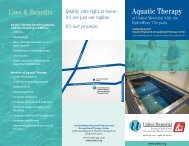2011 Annual Report - United Memorial Medical Center
2011 Annual Report - United Memorial Medical Center
2011 Annual Report - United Memorial Medical Center
Create successful ePaper yourself
Turn your PDF publications into a flip-book with our unique Google optimized e-Paper software.
Electronic Health Records<br />
Electronic health records improve care by enabling functions that<br />
paper records cannot deliver.<br />
• Makes a patient’s health information available when and<br />
where it is needed; not locked away in an one office or another.<br />
• Brings a patient’s total health information together in one<br />
place, and keeps it current; clinicians have access to information<br />
about the drugs or treatments prescribed by other<br />
providers, so care is better coordinated.<br />
• Supports better follow-up information for patients. For example,<br />
after a clinical visit or hospital stay, instructions and<br />
information for the patient can be provided effortlessly; and<br />
reminders for other follow-up care can be sent easily or even<br />
automatically to the patient.<br />
• Improves patient and provider convenience. Patients can<br />
have their prescriptions ordered and ready before even<br />
leaving the provider’s office; and insurance claims can be<br />
filed immediately from the provider’s office.<br />
• Links information with patient computers to point to additional<br />
resources. Patients can be more informed and involved<br />
as electronic health records are used to help identify<br />
additional web resources.<br />
• Does more than just “contain” or transmit information. Can<br />
also compute with it. For example, certain record systems<br />
can not only contain a list of a patient’s medications or allergies,<br />
they can also automatically check for problems whenever<br />
a new medication is prescribed and then alert the clinician<br />
to potential conflicts.<br />
• Improves safety with the capacity to bring all of a patient’s<br />
information together and to automatically identify potential<br />
safety issues; assists clinicians by providing “decision support”<br />
capability.<br />
• Delivers more information in more directions while reducing<br />
“paperwork” time for providers. For example, electronic<br />
health records can be programmed for easy or automatic<br />
delivery of information that needs to be shared with public<br />
health agencies or quality measurement, saving clinician<br />
time.<br />
• Improves privacy and security. With proper training and<br />
effective policies, electronic records can be more secure<br />
than paper.<br />
• Reduces costs through reduced paperwork, improved safety,<br />
reduced duplication of testing, and most of all improved<br />
health through the delivery of more effective health care.<br />
Source: U.S. Department of Health and Human Services<br />
To achieve these goals, an 8 step process for EMR<br />
adoption was established for U.S. hospitals with<br />
the ARRA funds available as an incentive to offset<br />
the cost of implementation. Healthcare providers<br />
must meet strict timelines and criteria established<br />
by CMS to qualify.<br />
In the past four years, <strong>United</strong> <strong>Memorial</strong> has invested<br />
over $10.5 million in information technology.<br />
“This aggressive initiative has helped<br />
UMMC reach federally established criteria for<br />
achieving “meaningful use” in order to fully<br />
benefit from the stimulus dollars available,”<br />
stated Mark C. Schoell, President and CEO,<br />
“more importantly, by improving our information<br />
technology we are improving the quality of<br />
care provided to our patients.”<br />
In <strong>2011</strong>, UMMC was in the top 5% of hospitals,<br />
nationally, to reach the Stage 6 requirements for<br />
an EMR Adoption Model. Attaining a Stage 6<br />
designation indicates that a hospital has achieved<br />
a high degree of clinical automation that is incorporated<br />
into the patient care services it delivers<br />
and provides the highest levels of patient safety<br />
and quality outcomes. In 2012, UMMC began<br />
working towards completion of Stage 7 objectives<br />
and full adoption of the EMR.<br />
In February and March 2012, <strong>United</strong> <strong>Memorial</strong><br />
received its first installment of electronic medical<br />
record meaningful use funds in the combined<br />
amount of $2.4 million. All funds will be used<br />
towards further enhancements to the organization’s<br />
health information technology.





